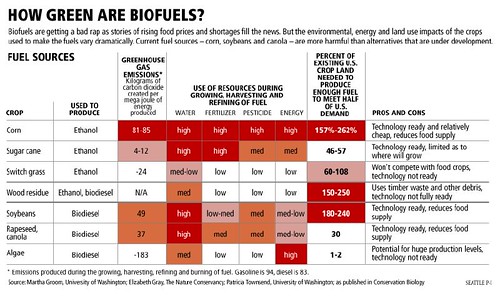Biofuels Get a Boost – Secretary Chu Announces Nearly $800 Million from Recovery Act to Accelerate Biofuels Research and Commercialization
(Source: GreenBiz via Reuters)

The Obama administration established a Biofuels Interagency Working Group this week in a move that carries implications for the industry on several fronts, including regulatory and research and development.

The Biofuels Interagency Working Group, comprised of the U.S. Environmental Protection Agency, Department of Energy (DOE) and Department of Agriculture, will develop a biofuel market development program, coordinate biofuel infrastructure policies, study biofuel lifecycle and help existing biofuel producers secure credit and refinancing.
Meanwhile, the DOE will spend $786.5 million in stimulus funds on demonstration projects and research to accelerate the adoption of next-generation biofuels.
For example, the agency will dole out $480 million on 10 to 20 pilot-scale and demonstration-scale projects, with a ceiling of $25 million and $50 million, respectively. Another $176.5 million shall be used to increase funding for two or more commercial-scale biorefinery projects that previously received government assistance.
The DOE biomass program also will dedicate $130 million toward research into ethanol, algal biofuels and biofuel sustainability research.
The proposal breaks down renewable fuels into four categories: cellulosic biofuels, biomass-derived diesel, advanced biofuels, and total renewable fuel. The fuels must produce fewer greenhouse gas emissions than conventional fuels, but there is great debate within the biofuel industry about how these lifecycle assessments should be calculated.
$480 million solicitation for integrated pilot- and demonstration-scale biorefineries
Projects selected under this Funding Opportunity Announcement will work to validate integrated biorefinery technologies that produce advanced biofuels, bioproducts, and heat and power in an integrated system, thus enabling private financing of commercial-scale replications.
DOE anticipates making 10 to 20 awards for refineries at various scales and designs, all to be operational in the next three years. The DOE funding ceiling is $25 million for pilot-scale projects and $50 million for demonstration scale projects.
These integrated biorefineries will reduce dependence on petroleum-based transportation fuels and chemicals. They will also facilitate the development of an “advanced biofuels” industry to meet the federal Renewable Fuel Standards.

